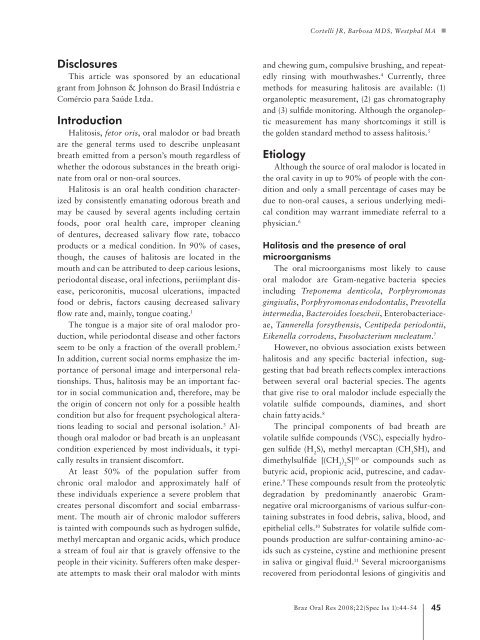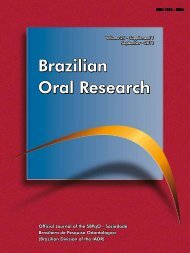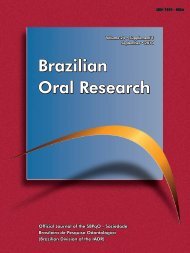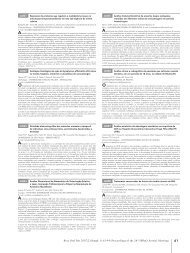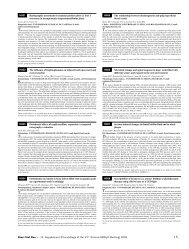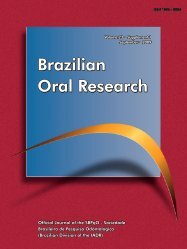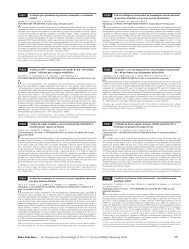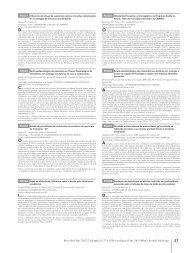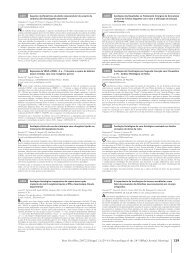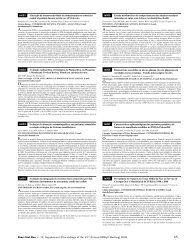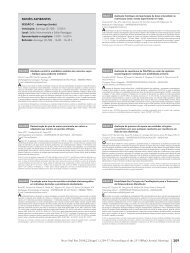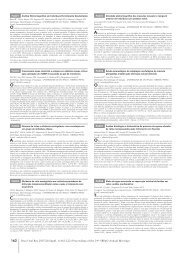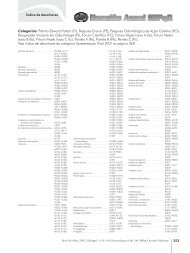Brazilian Oral Research Brazilian Oral Research Brazilian Oral
Brazilian Oral Research Brazilian Oral Research Brazilian Oral
Brazilian Oral Research Brazilian Oral Research Brazilian Oral
Create successful ePaper yourself
Turn your PDF publications into a flip-book with our unique Google optimized e-Paper software.
Disclosures<br />
This article was sponsored by an educational<br />
grant from Johnson & Johnson do Brasil Indústria e<br />
Comércio para Saúde Ltda.<br />
Introduction<br />
Halitosis, fetor oris, oral malodor or bad breath<br />
are the general terms used to describe unpleasant<br />
breath emitted from a person’s mouth regardless of<br />
whether the odorous substances in the breath originate<br />
from oral or non-oral sources.<br />
Halitosis is an oral health condition characterized<br />
by consistently emanating odorous breath and<br />
may be caused by several agents including certain<br />
foods, poor oral health care, improper cleaning<br />
of dentures, decreased salivary flow rate, tobacco<br />
products or a medical condition. In 90% of cases,<br />
though, the causes of halitosis are located in the<br />
mouth and can be attributed to deep carious lesions,<br />
periodontal disease, oral infections, periimplant disease,<br />
pericoronitis, mucosal ulcerations, impacted<br />
food or debris, factors causing decreased salivary<br />
flow rate and, mainly, tongue coating. 1<br />
The tongue is a major site of oral malodor production,<br />
while periodontal disease and other factors<br />
seem to be only a fraction of the overall problem. 2<br />
In addition, current social norms emphasize the importance<br />
of personal image and interpersonal relationships.<br />
Thus, halitosis may be an important factor<br />
in social communication and, therefore, may be<br />
the origin of concern not only for a possible health<br />
condition but also for frequent psychological alterations<br />
leading to social and personal isolation. 3 Although<br />
oral malodor or bad breath is an unpleasant<br />
condition experienced by most individuals, it typically<br />
results in transient discomfort.<br />
At least 50% of the population suffer from<br />
chronic oral malodor and approximately half of<br />
these individuals experience a severe problem that<br />
creates personal discomfort and social embarrassment.<br />
The mouth air of chronic malodor sufferers<br />
is tainted with compounds such as hydrogen sulfide,<br />
methyl mercaptan and organic acids, which produce<br />
a stream of foul air that is gravely offensive to the<br />
people in their vicinity. Sufferers often make desperate<br />
attempts to mask their oral malodor with mints<br />
Cortelli JR, Barbosa MDS, Westphal MA<br />
and chewing gum, compulsive brushing, and repeatedly<br />
rinsing with mouthwashes. 4 Currently, three<br />
methods for measuring halitosis are available: (1)<br />
organoleptic measurement, (2) gas chromatography<br />
and (3) sulfide monitoring. Although the organoleptic<br />
measurement has many shortcomings it still is<br />
the golden standard method to assess halitosis. 5<br />
Etiology<br />
Although the source of oral malodor is located in<br />
the oral cavity in up to 90% of people with the condition<br />
and only a small percentage of cases may be<br />
due to non-oral causes, a serious underlying medical<br />
condition may warrant immediate referral to a<br />
physician. 6<br />
Halitosis and the presence of oral<br />
microorganisms<br />
The oral microorganisms most likely to cause<br />
oral malodor are Gram-negative bacteria species<br />
including Treponema denticola, Porphyromonas<br />
gingivalis, Porphyromonas endodontalis, Prevotella<br />
intermedia, Bacteroides loescheii, Enterobacteriaceae,<br />
Tannerella forsythensis, Centipeda periodontii,<br />
Eikenella corrodens, Fusobacterium nucleatum. 7<br />
However, no obvious association exists between<br />
halitosis and any specific bacterial infection, suggesting<br />
that bad breath reflects complex interactions<br />
between several oral bacterial species. The agents<br />
that give rise to oral malodor include especially the<br />
volatile sulfide compounds, diamines, and short<br />
chain fatty acids. 8<br />
The principal components of bad breath are<br />
volatile sulfide compounds (VSC), especially hydrogen<br />
sulfide (H 2 S), methyl mercaptan (CH 3 SH), and<br />
dimethylsulfide [(CH 3 ) 2 S] 10 or compounds such as<br />
butyric acid, propionic acid, putrescine, and cadaverine.<br />
9 These compounds result from the proteolytic<br />
degradation by predominantly anaerobic Gramnegative<br />
oral microorganisms of various sulfur-containing<br />
substrates in food debris, saliva, blood, and<br />
epithelial cells. 10 Substrates for volatile sulfide compounds<br />
production are sulfur-containing amino-acids<br />
such as cysteine, cystine and methionine present<br />
in saliva or gingival fluid. 11 Several microorganisms<br />
recovered from periodontal lesions of gingivitis and<br />
Braz <strong>Oral</strong> Res 2008;22(Spec Iss 1):44-54<br />
4


